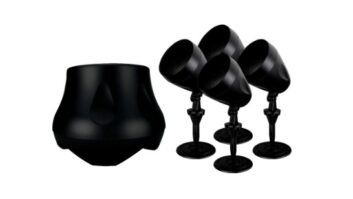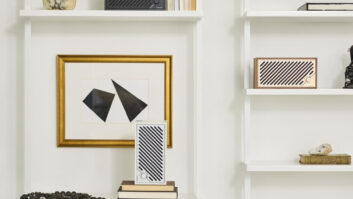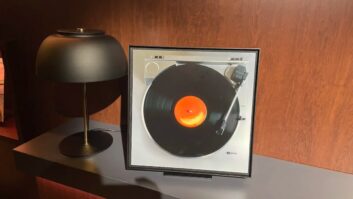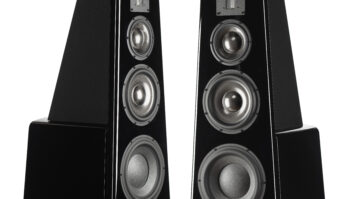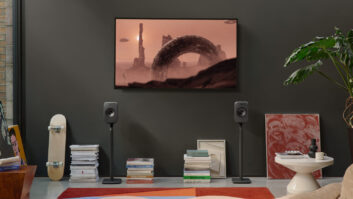Home component-audio sales spiraled downward in 2005, but component speakers largely escaped the fate of their electronic brethren, driven up in dollars by consumers’ growing interest in step-up models, CEA statistics show.
Speaker suppliers hope to keep the momentum going in 2006 with more of what drove dollars up last year: higher performance and design-oriented models that complement ever-popular flat-panel TVs and narrow-profile rear-projection TVs.
Here at International CES, dealers will find more suppliers launching their first speakers to complement popular leading-edge displays with long, narrow-enclosure, small-footprint speakers often suitable for wall hanging. The suppliers include Cambridge SoundWorks, JBL, MTX and PSB. Other companies, such as Definitive Technology, Klipsch and Paradigm, will expand their selection of speakers for these applications.
Still other companies, including Infinity and Tymphany, will demonstrate completely new approaches to speaker design to complement the new video displays (see p. 106).
Taking a different approach to encouraging step-up sales, Jamo will unveil a floorstanding, enclosure-less speaker said to raise performance beyond the capability of traditional cabinet designs, (see p. 108) and startup Avega will show active networked speakers that incorporate wireless and digital processors to stream and play back music from PCs or networked media servers (see p. 106).
Other companies, such as Klipsch, will introduce DSP in subwoofers to compensate for the deleterious affects of a room’s acoustics.
With these and other introductions, suppliers hope to repeat last year’s sales momentum. Although factory-level unit sales fell 8 percent to 4.24 million during the first three quarters, dollar volume rose 7 percent to $342.3 million.
Here’s how various suppliers hope to encourage step-up sales:
Boston Acoustics: The E-Series is designed to complement plasma and LCD televisions and monitors, DLP rear-projection consoles and traditional screens.
The five-model series comprises the E40 and E60 bookshelf speakers, the E50 and E70 LCRs for use on bookshelves and floor stands, and the flagship E100. All cabinets are designed to be decorator- and installer-friendly, featuring, for example, removable side panels that allow each speaker to be customized to match a home’s décor, the company said. E-Series speakers will be available early in 2006 for the United States only. Pricing was not available at press time.
The new powered subwoofer line consists of the XB2, XB4 and XB6, all with built-in amplifiers ranging up to 200 watts for the XB6. All three are front firing and front ported. They ship in the first half at suggested prices of $300, $400 and $500, respectively.
Cambridge SoundWorks: The company’s first speakers for flat-panel displays are the Newton Series MC600 LCR and the MC300 powered sub. The LCR, intended for displays at least 40 inches in size, features four 3.5–inch woofers and a dome tweeter in a cast-aluminum housing with 2.5-way crossover. They’re voiced to match the company’s Newton and Ambience series of in-wall speakers. The sub features six 5.25-inch woofers and 300-watt Class D amp in a tall, slim MDF cabinet with steel side panels. Three woofers are embedded on opposing sides of the cabinet to neutralize vibration. They ship in February at an unannounced price.
Infinity: The brand plans January shipments of its Cascade series speakers, which incorporate rectangular flat-panel drivers said to combine the advantages of circular cone drivers and flat-panel, planar-magnetic drivers to create high-accuracy, high-output speakers in small, narrow-baffle enclosures. The products were originally due last October.
The Cascade series includes a mix of floorstanding and shelf speakers and a center-channel speaker. The shelf speakers and center-channel speaker can be mounted on shelf stands or on the wall next to a flat-panel TV.
Prices on left-right models range from a suggested $699 to $999 each, depending on the choice of three finishes. Two powered subwoofers that don’t use the technology retail for a suggested $999 and $1,499 each.
Klipsch: The company is replacing almost all of its top-end Reference series of cabinet speakers with the launch of 20 new models, all intended for specialty retailers. The front left-right models sport narrower, taller profiles for use with flat-panel TVs. The new models consist of five floorstanding models, three bookshelf models, three center channels, three surrounds and six powered subs — including the line’s first with DSP and first two with digital room-error correction.
In the fourth-generation series, the floorstanding models have been improved to deliver smoother, more detailed sound and more bass output, the company said. They retail for a suggested $598 to $2,498 per pair. The three bookshelves feature improved bass response and sell at suggested retails of $248 to $698 per pair. Two of three center channels offer improved bass response, and one, the top-end R64 at a suggested $899, features an all-new design consisting four 6.5-inch woofers flanking a 1.25-inch tweeter. The other two speakers, at $299 and $449, feature two woofers flanking a tweeter.
The three surrounds adopt a new cabinet design and driver layout to improve coverage and output. Each cabinet features dual baffles, angled away from each other with a woofer and tweeter on each baffle, to deliver surround effects over 180-degree. As a result, “sound points at you no matter where you are seated,” said product marketing director Jim Garrett. Prices range from $448 to $998 per pair.
Six powered sub include two triangular-shaped models that can be corner-loaded to create a 6dB boost in output. All but one feature DSP to customize bass performance, including user-adjustable digital equalization presets. Two models add digital room-error correction. Suggested retails range from $349 to $1,999.
MTX Audio: A new line of speakers is designed for placement next to flat-panel LCD and plasma TVs without costly installs and without taking up a lot of space. All models can rotate to deliver improved imaging to any listening position.
The MPP series consists of four models, each for a different-size TV. Each can be mounted on stands for traditional floorstanding speaker positioning or side-mounted to the TV screen to blend in seamlessly with the television for a more stealthy appearance. Virtually undetectable mounting brackets securely hold the speakers flush with the screen. All models are ported to enhance low-frequency response and magnetically shielded to protect from video interference.
They’re available in black, white and silver to match any television in any room.
Paradigm: Additions to the Cinema speaker line are the Cinema 220 and Cinema 330, both LCR speakers that can be deployed horizontally or vertically and feature long, slim enclosures.
The Cinema 220’s cabinet is 20.2 inches by 4.7 inches by 5.7 inches, and the Cinema 330 is 24.5 inches by 4.2 inches by 6.3 inches. Both models include an adjustable TV-top/shelf support for use when the center speaker is placed horizontally for configuration. Both models are available in silver, white or black. Pricing and ship dates will be available at the show.
PSB: The brand targeted flat-screen owners with the VisionSound series of enclosed speakers, delayed until the first quarter from November. The $749-each VS400 is a floorstanding model, and the $999-each VS300 is designed for wall mounting next to 42-inch and larger flat-panel displays. The VS300’s included wall-mount bracket becomes a center-channel stand when two feet are added. Another option turns the speaker into a tabletop minitower. Both speakers feature extruded-aluminum enclosure and 4.5-inch woofers to maintain a svelte look.
Snell: The company plans to expand its Series 7 with the three-way floorstanding C7 Tower, due in the first quarter at $2,500 each. Series 7 is Snell’s first complete line created from the ground up by designer Joe D’Appolito, who used his D’Appolito driver array to deliver broad and even vertical dispersion. In this array, dual 4-inch midrange drivers appear above and below a 1-inch silk dome tweeter to enable groups of listeners to enjoy smooth response and a wide front stage.
It also features rear-firing tweeter, two-position treble switch to match room acoustics and program requirements, and boundary- and perforated-screen compensation adjustments.
Two 8-inch aluminum cone woofers are placed on either side of the cabinet near the bottom of the enclosure, allowing the back wave of the woofers to “Force Balance” each other to produce less cabinet resonance. It is capable of tremendous output — over 110dB — and delivers bass down to almost 30Hz.






